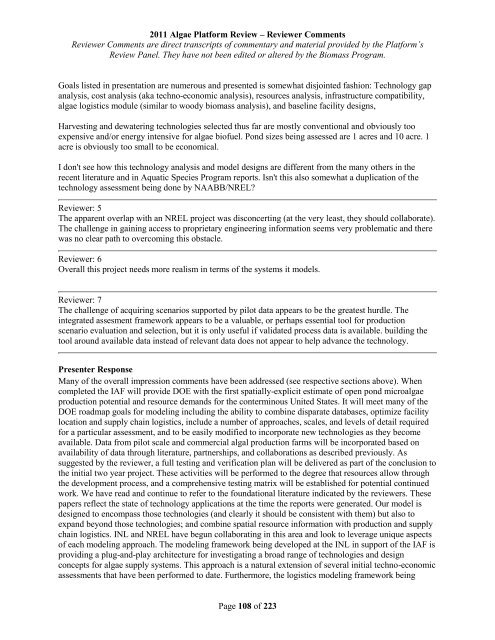Reviewer Comments - EERE
Reviewer Comments - EERE
Reviewer Comments - EERE
Create successful ePaper yourself
Turn your PDF publications into a flip-book with our unique Google optimized e-Paper software.
2011 Algae Platform Review – <strong>Reviewer</strong> <strong>Comments</strong><br />
<strong>Reviewer</strong> <strong>Comments</strong> are direct transcripts of commentary and material provided by the Platform’s<br />
Review Panel. They have not been edited or altered by the Biomass Program.<br />
Goals listed in presentation are numerous and presented is somewhat disjointed fashion: Technology gap<br />
analysis, cost analysis (aka techno-economic analysis), resources analysis, infrastructure compatibility,<br />
algae logistics module (similar to woody biomass analysis), and baseline facility designs,<br />
Harvesting and dewatering technologies selected thus far are mostly conventional and obviously too<br />
expensive and/or energy intensive for algae biofuel. Pond sizes being assessed are 1 acres and 10 acre. 1<br />
acre is obviously too small to be economical.<br />
I don't see how this technology analysis and model designs are different from the many others in the<br />
recent literature and in Aquatic Species Program reports. Isn't this also somewhat a duplication of the<br />
technology assessment being done by NAABB/NREL?<br />
<strong>Reviewer</strong>: 5<br />
The apparent overlap with an NREL project was disconcerting (at the very least, they should collaborate).<br />
The challenge in gaining access to proprietary engineering information seems very problematic and there<br />
was no clear path to overcoming this obstacle.<br />
<strong>Reviewer</strong>: 6<br />
Overall this project needs more realism in terms of the systems it models.<br />
<strong>Reviewer</strong>: 7<br />
The challenge of acquiring scenarios supported by pilot data appears to be the greatest hurdle. The<br />
integrated assesment framework appears to be a valuable, or perhaps essential tool for production<br />
scenario evaluation and selection, but it is only useful if validated process data is available. building the<br />
tool around available data instead of relevant data does not appear to help advance the technology.<br />
Presenter Response<br />
Many of the overall impression comments have been addressed (see respective sections above). When<br />
completed the IAF will provide DOE with the first spatially-explicit estimate of open pond microalgae<br />
production potential and resource demands for the conterminous United States. It will meet many of the<br />
DOE roadmap goals for modeling including the ability to combine disparate databases, optimize facility<br />
location and supply chain logistics, include a number of approaches, scales, and levels of detail required<br />
for a particular assessment, and to be easily modified to incorporate new technologies as they become<br />
available. Data from pilot scale and commercial algal production farms will be incorporated based on<br />
availability of data through literature, partnerships, and collaborations as described previously. As<br />
suggested by the reviewer, a full testing and verification plan will be delivered as part of the conclusion to<br />
the initial two year project. These activities will be performed to the degree that resources allow through<br />
the development process, and a comprehensive testing matrix will be established for potential continued<br />
work. We have read and continue to refer to the foundational literature indicated by the reviewers. These<br />
papers reflect the state of technology applications at the time the reports were generated. Our model is<br />
designed to encompass those technologies (and clearly it should be consistent with them) but also to<br />
expand beyond those technologies; and combine spatial resource information with production and supply<br />
chain logistics. INL and NREL have begun collaborating in this area and look to leverage unique aspects<br />
of each modeling approach. The modeling framework being developed at the INL in support of the IAF is<br />
providing a plug-and-play architecture for investigating a broad range of technologies and design<br />
concepts for algae supply systems. This approach is a natural extension of several initial techno-economic<br />
assessments that have been performed to date. Furthermore, the logistics modeling framework being<br />
Page 108 of 223




